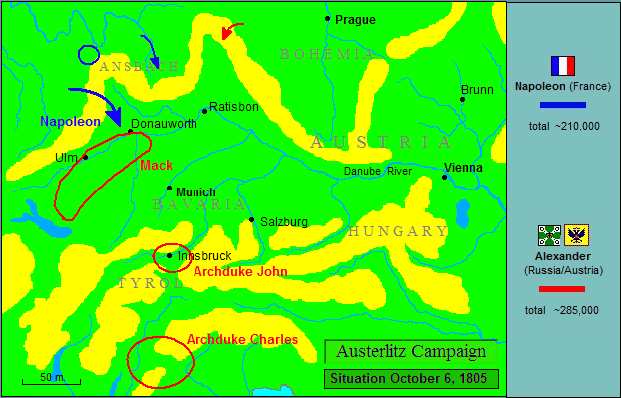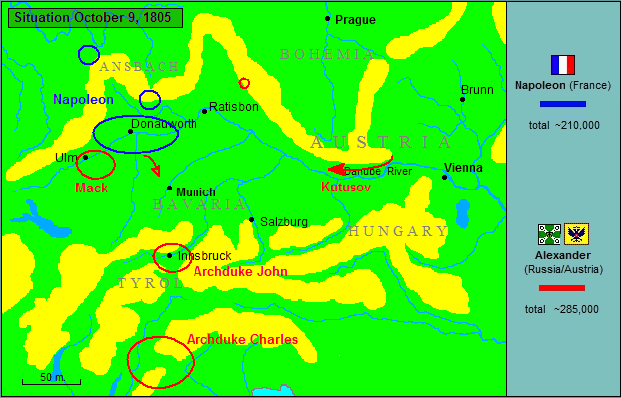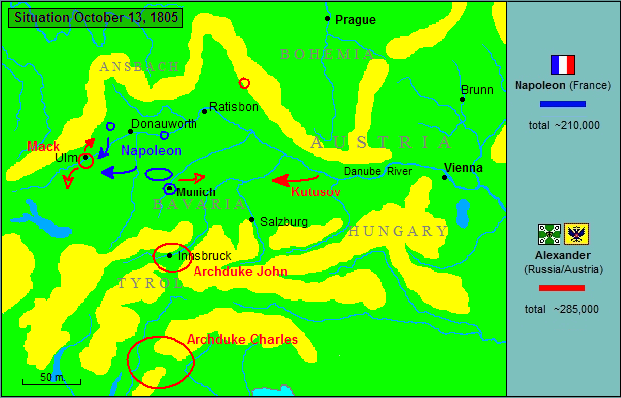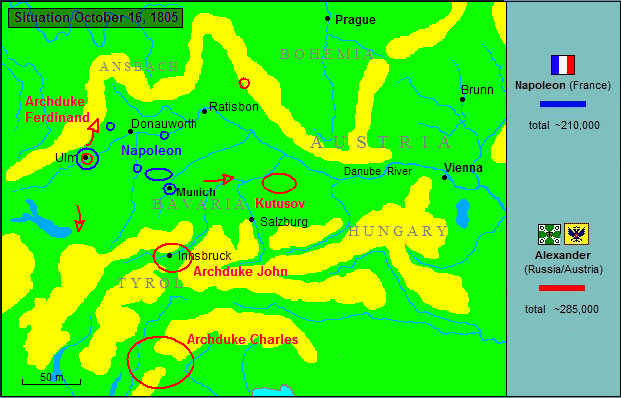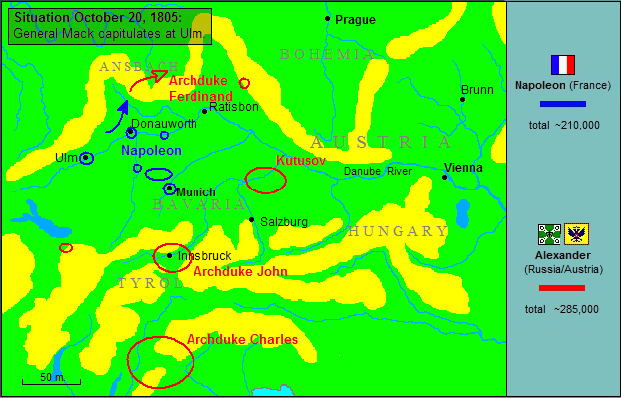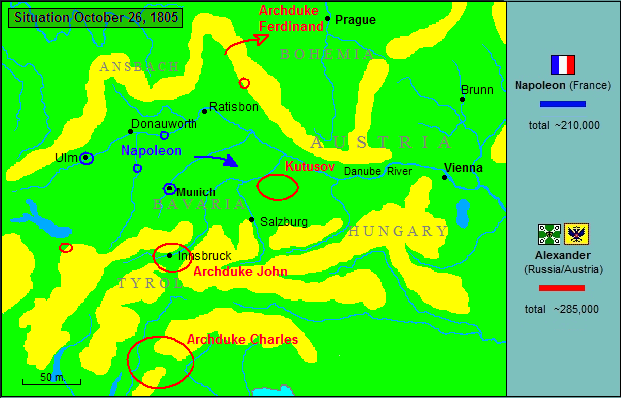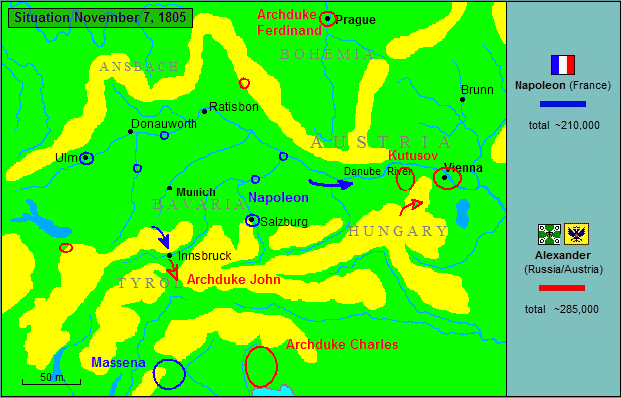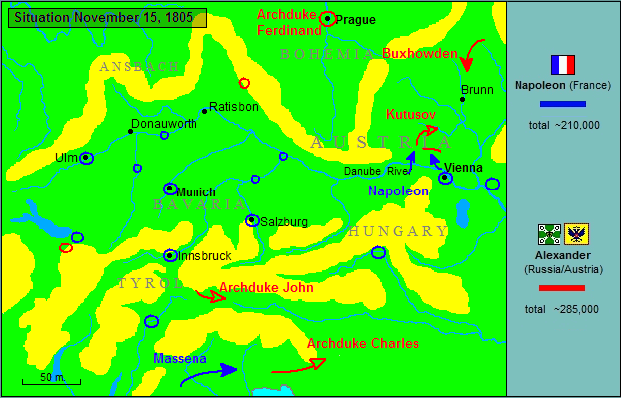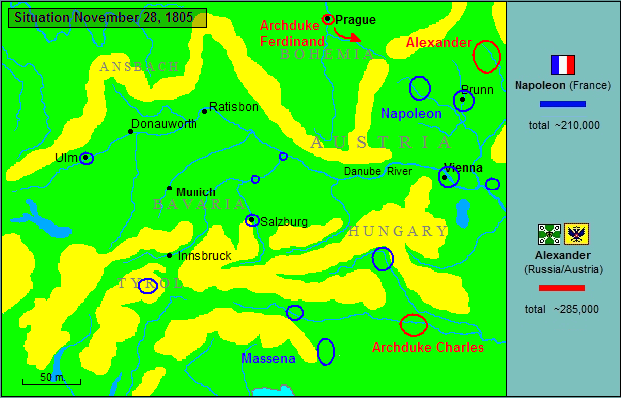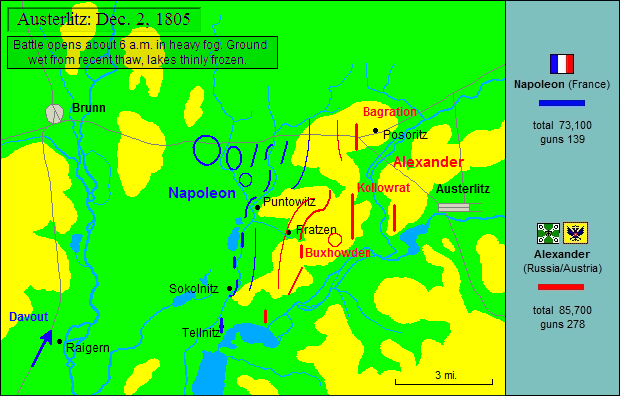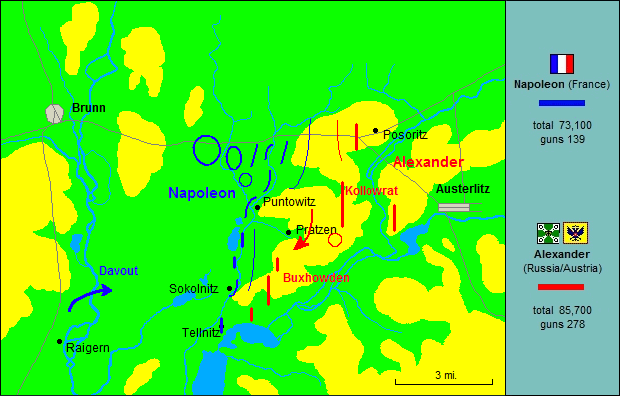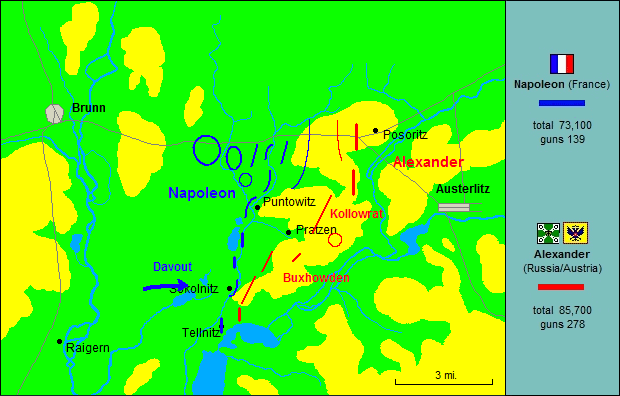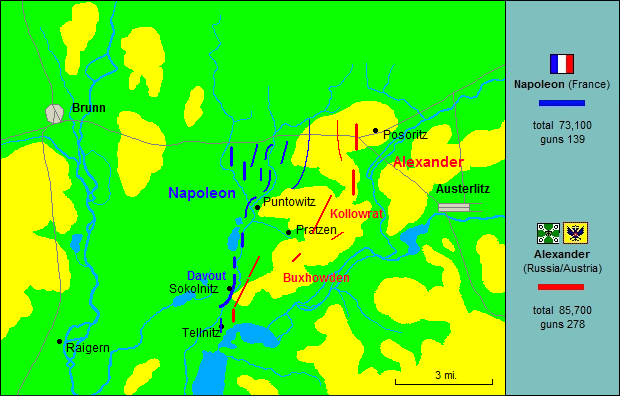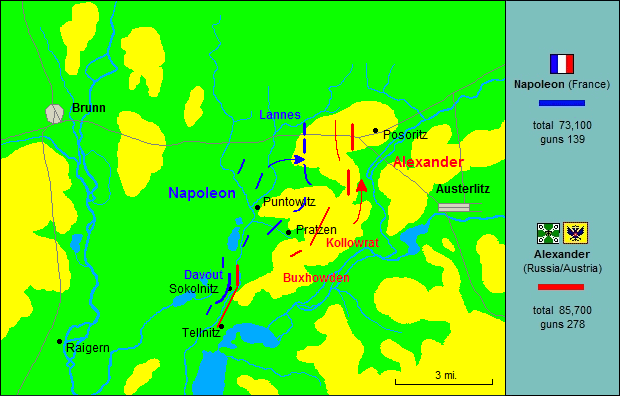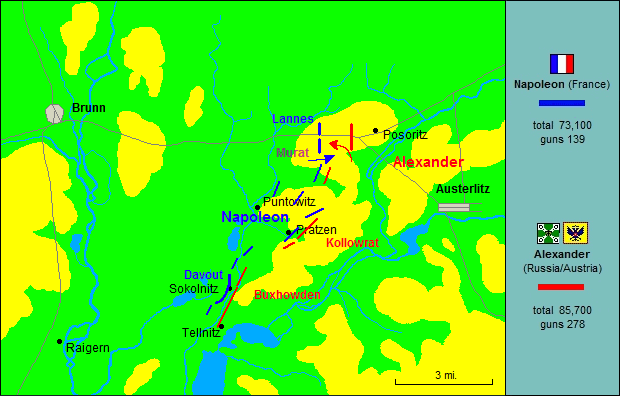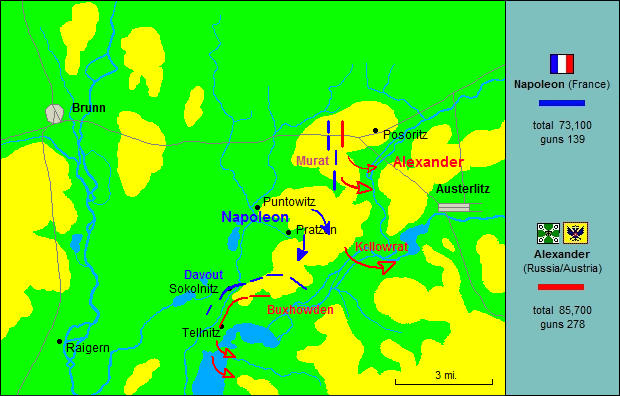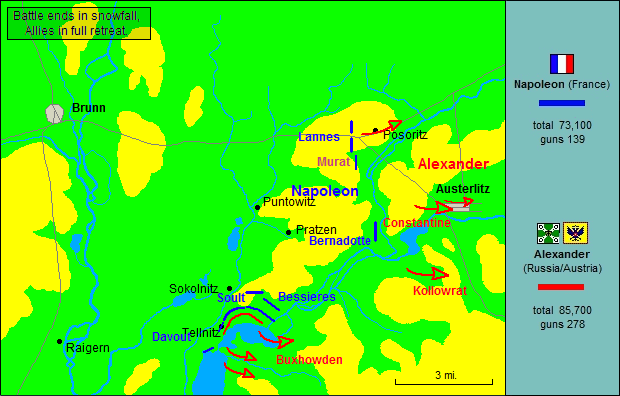Soldats, Je suis content de vous.
–Napoleon, at Austerlitz
In late summer of 1805, with Villeneuve’s fleet no longer expected in Boulogne and Austrian troops massing in Italy and Tyrol, Napoleon made a dramatic change of plans. Abandoning the notion of an invasion of England, he determined instead to employ the massive army he had assembled in and around the channel ports in a campaign to oppose an anticipated allied advance up the Danube, which, if launched, would pose a direct threat to the French homeland. Comprised of over 200,000 men in seven self-sufficient corps, what had been known as the Army of England now became simply the Grand Army. On 24 August, Napoleon ordered the army’s cavalry commander, Murat, to assemble his forces along the Rhine opposite Baden and the Black Forest, and three days later, under heightened secrecy, the great mass of infantry followed, heading for positions along a front running from Mayence to Strasbourg. Once the corps were in place and all preparations made, the army would be poised to make a concerted thrust eastward with the goal of isolating the Austrian army before it could unite with a Russian force advancing through Galicia, on the border of modern Ukraine and Poland.
For their part, the Austrians anticipated the French plan and moved quickly to preempt it. On 2 September a large Austrian force under General Karl Mack advanced into Bavaria and began concentrating on Ulm, forming a defensive line running roughly from Lake Constance northeast along the upper Danube. With the Prussian territory of Ansbach securing his right flank, Mack prepared to confront an anticipated French drive through the Black Forest, while a Russian army under Mikhail Kutusov was on the march to join him. There was only one catch; neither allied commander had taken into account that the Russian calendar was fully ten days out of step with the rest of Europe. Thus, the Russian advance on which Mack was depending would be ten days late getting started, and with over 600 miles to travel could not be expected for several weeks. The error would prove decisive.
By the last week of September, having learned of Mack’s incursion into Bavaria, Napoleon was ready to launch his own offensive. Breaking off diplomatic relations with the Austrians, he left Paris to join the army, and the next day his leading corps crossed the Rhine at Strasbourg. His general plan was to suggest an advance through the Black Forest (as Mack anticipated), while the bulk of the army actually swept eastward along a broad front running as far north as Mayence. A lack of bridging materials delayed three of his corps, but by the 30th all were across the Rhine and pressing forward deep into German territory. On 3 October, in a move calculated to throw the enemy further off balance, the northernmost French corps crossed into Ansbach, violating Prussian neutrality as they raced for the Danube. Prussia could be dealt with later; Napoleon’s first concern was to concentrate east of Ulm and trap the bulk of the Austrian army in much the same way he had in the Marengo campaign. Taken by surprise, General Mack, who had been waiting for the heads of the French columns to appear along the expected route through the Black Forest, suddenly found himself massively outflanked and powerless to prevent the enemy from crossing south of the Danube to a position in his rear. Once again an otherwise capable old-school commander had simply failed to account for the speed and audacity of the French advance. Even so, recognizing the hazard of attempting to retreat under such conditions, Mack gamely sought to hold on at Ulm in hope of relief from Kutusov.
Meanwhile, anxious to cut off all lines of retreat, Napoleon pressed his army forward. On 9 October he advanced as far south as Augsburg and as far east as Ingolstadt, putting himself squarely across Mack’s line of retreat. Assuming that his foe would attempt to escape to the south, he made little allowance for an Austrian withdrawal to the northeast, across the wake of the French advance. Compounding this error, Marshal Ney, who had been ordered to push the remaining Austrians out of Ulm, crossed most of his force to the south bank of the Danube to link up with the rest of the army, leaving only a single division, Dupont’s, north of the river at Albeck. Unfortunately for Dupont, this came about just as Mack moved to break out of the trap, and on the 11th the French general marched upon Haslach only to run into two Austrian corps moving in the opposite direction. Putting up a strong defense, the French managed to stave off disaster and retreat under cover of darkness, leaving the Austrians in a position to visit a good deal of destruction on the French supply trains. The fighting at Haslach had worn out much of the Austrian cavalry, however, and with inexplicable optimism General Mack postponed the advance until the 13th, interpreting reports of French movements westward from Landsberg as a general retreat back to France!
This was wishful thinking indeed, for his escape route was about to be cut off, leaving him completely surrounded. Alerted to the precariousness of his situation north of the Danube, Napoleon ordered Ney to recross the river, and on the 14th, despite the partial destruction of the bridge at Elchingen, Ney’s troops stormed across what remained of the battered structure and engaged the Austrians in a running ten-hour battle, pushing them back upon Ulm. (Though originally reproached for failing to secure the crossing, Ney would later be granted a title for retaking the town, becoming the Duke of Elchingen.) At this point Archduke Ferdinand broke with the Austrian field commander and bolted toward Heidenheim, taking with him as much as a third of Mack’s remaining force, including his heavy guns and the army’s supply trains. The escape was made with no time to spare; by the 16th, two French corps had returned north of the river to invest Ulm, and Murat’s cavalry was hot on the enemy’s heels. Meanwhile, the remnants of Mack’s army held out in Ulm in the forlorn hope that Kutusov would arrive in time to relieve him. Four days later, with the Russians 150 miles away and already exhausted by their advance, Mack surrendered.
Thus far Napoleon had driven his troops at a nearly superhuman pace, and with the remaining armies of the coalition still bent on his destruction there would be little letup. Despite the burdens imposed by a large number of stragglers and as many as 60,000 prisoners, in the week following Mack’s capitulation the tireless French emperor restored his communications (disrupted by Ferdinand’s escape), brought up fresh supplies, and prepared for another advance. On the 26th he was underway again, pressing his reorganized corps forward in three columns with the aim of defeating the Russians before they could be reinforced.
Meanwhile, upon learning of Mack’s surrender, Kutusov, with only 36,000 road-weary troops, had begun withdrawing to a point northeast of Vienna to await the arrival of another Russian army under General Buxhowden. At the same time, in an attempt to delay the French advance, the Austrian emperor attempted to open peace talks. Napoleon, who had made several peace overtures in advance of the stunning French victory at Ulm, would have none of it now. Pressing his main force eastward, he sent Marshal Ney south upon Innsbruck, where the fiery corps commander drove an Austrian army under Archduke John through the Brenner Pass. Once again the speed of the French juggernaut took the enemy by surprise, forcing the Austrians back by the sheer momentum of its advance. Reaching Vienna on 15 November, Napoleon took up residence in the Schonbrunn Palace, from whose elegant windows he could look out upon the fruits of an amazingly swift and successful campaign. Even belated news of Villeneuve’s defeat at Trafalgar could not tarnish his recent successes. And yet the military situation was still highly uncertain. Now over four hundred miles from France, his army worn out and much reduced in number by two months of hard campaigning, he faced a combined force of some 86,000 men (mostly Russian), with another, larger Austrian army under Archduke Charles on the way north from Venetia. In addition, Prussia, with another 190,000 men, showed every intention of joining the Allies at the first opportunity.
At this point, Kutusov and his Austrian allies lay northeast of Vienna at Olmutz, where they were joined by a second Russian army under Buxhowden. Initially, the Allied commanders planned to await the arrival of Archduke Charles, whose numbers promised a combined strength of some 150,000 men. This would take time, however, and the Allied armies were already exhausting the limited resources of the Moravian countryside. It soon became apparent that, with winter fast approaching, they must either force the issue or retreat and await the next campaigning season. For Napoleon, the opportunity offered to strike before the enemy could recover his strength, and thus he undertook an artful ruse, advancing somewhat tentatively upon Brunn and calling for negotiations. Thinking the peace overtures a sign of weakness, Tsar Alexander advanced upon the village of Austerlitz and on 30 November offered to make peace on the utterly unrealistic condition that the French evacuate all territories occupied since 1792! The Russian emperor had clearly taken the bait. Napoleon of course refused the offer, yet timorously withdrew from a central plateau known as the Pratzen Heights, a move designed to bolster the Tsar’s confidence. And sure enough, encouraged by continuing signs of French anxiety, Alexander occupied the high ground with plans to strike southward, envelop the enemy right, and cut off the French retreat toward Vienna. What he did not realize was that he was rushing into a carefully laid trap.
At 7 a.m. on the foggy morning of 2 December 1805, the main Allied attack stepped off in the pre-dawn twilight, descending from the Pratzen Heights and advancing on the villages of Tellnitz and Sokolnitz. Here, a tenacious French defense–supported by the timely arrival of Davout’s corps–held the Austrian advance in check along Goldbach Brook, the fierceness of the French resistance eventually drawing additional Allied forces southward and creating a noticeable gap in the Allied line. Meanwhile, from his headquarters on a hill immediately south of the Olmutz-Brunn Road, Napoleon could see above the fog to the heights opposite, where he detected the enemy’s movement to the south and the resulting weak spot. It was the opportunity he had been waiting for, and, having massed the bulk of his forces north of Kobelnitz, he sent Soult’s corps forward to occupy the vulnerable Russian center.
Rising up out of the fog-shrouded lowland, Soult’s two divisions caught a single enemy corps in the midst of displacing southward. Sweeping an Allied covering force out of the village of Pratzen, one division attacked the hastily-reforming troops and a series of fierce charges and counter-charges ensued. Next, the second division fell on the enemy right, and under its weight, the Allied lines broke apart and began streaming eastward toward Austerlitz. Scarcely pausing in the wake of this rout, Soult’s divisions wheeled right and pressed southward against the Allied flanking force, which continued to be stalled around Tellnitz and Sokolnitz. Recognizing the danger, Kutusov ordered his entire reserve forward to regain the heights, achieving a momentary success when the Russian Guard cavalry overwhelmed an isolated French brigade. Napoleon responded by sending his own Guard cavalry forward, and in a series of determined charges, the elite French horsemen captured the bulk of their enemy counterparts along with their commander. At this point, the rest of the Allied reserve broke and ran. It was now noon, and above the billowing smoke of battle, a bright sun shone in the blue December sky. Soon to become part of the growing legend of the Grand Army, the “sun of Austerlitz” would come to symbolize the moment of victory, and with it the army’s effective domination of Europe.
The battle’s final action occurred on the extreme flanks of the two armies. To the north, Russian general Bagration seized the village of Bosenitz in an attempt to turn the French left. Coming under the muzzles of the French batteries on nearby Santon Hill, however, the Russians were soon blasted back and set upon by Murat’s cavalry. Meanwhile, to the south, after several hours’ respite in which he was joined by various reinforcements, Soult descended upon the now-isolated Allied flanking force around Tellnitz. Already thoroughly demoralized and disoriented, the exhausted Russians and Austrians attempted to orchestrate an orderly retreat but were soon fleeing for their lives. Chased across the frozen surface of a nearby pond, many were drowned when French artillery fire broke the ice. Meanwhile, in Austerlitz itself, all was chaos as Russian and Austrian troops streamed into and through the town, creating mass confusion. By four o’clock the day’s bright sunshine had given way to an approaching snowstorm, and for the Allied forces, the day ended in sudden darkness and abject defeat.
To be known as the Battle of the Three Emperors (Francis fled with Alexander during the collapse of the Allied right), Austerlitz is widely considered Napoleon’s greatest tactical victory. Both in the build-up to the battle and in the deployment and movement of troops on the field he showed a clear mastery of both the terrain and the psychology of his opponents. At a cost of some 2,000 French dead, the Grand Army inflicted over 15,000 casualties and captured another 11,000. Strategically, the results were even more significant, bringing about the collapse of the Third Coalition and effectively offsetting the naval defeat at Trafalgar. Employing a species of soldierly understatement, the new master of the continent delivered an official proclamation to the army: “Soldats, Je suis content de vous” (Soldiers, I am pleased with you). To the rank and file who held him in awe, their commander’s simple statement of satisfaction was received as the highest of honors.

